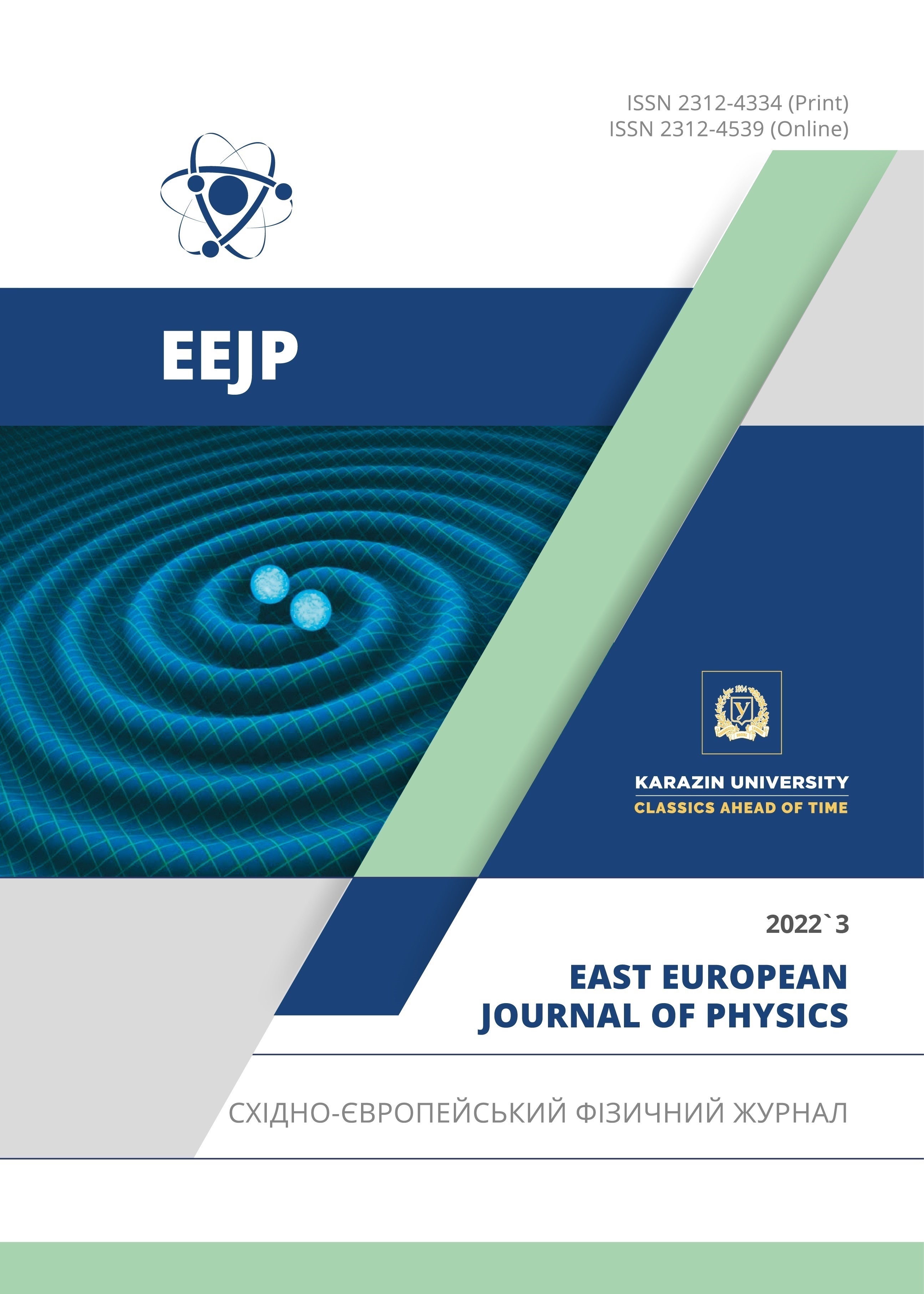Bianchi Type V Tsallis Holographic Dark Energy Model with Hybrid Expansion Law
Abstract
A number of recent cosmological observations have provided increasing evidence that currently the universe is undergoing a phase of accelerated expansion, the root cause of which is supposed to be due to an exotic component of the universe with large negative pressure, dubbed dark energy. Out of the various candidates of dark energy proposed in the literature, the holographic dark energy emerged from the Holographic Principle is drawing much attention in the research field. In this paper, we investigate a spatially homogeneous and anisotropic Bianchi Type V space-time filled with non-interacting Tsallis holographic dark energy (THDE) with Hubble horizon as the IR cutoff and pressureless cold dark matter within the framework of General Relativity. Exact solutions of the Einstein field equations are obtained by considering the average scale factor to be a combination of a power law and an exponential law, the so called hybrid expansion law first proposed by Akarsu et al. (2014). We study the cosmological dynamics of various models for different values of the non-additive parameter that appeared in the Tsallis entropy and that for that appeared in the exponential function of the hybrid expansion law. We find that our model exhibits present cosmological scenario.
Downloads
References
S. Perlmutter, G. Aldering, M. Della Valle, S. Deustua, R.S. Ellis, S. Fabbro, A. Fruchter, et al, “Discovery of supernovae explosion at half the age of the universe”, Nature, 391, 51 (1998). https://doi.org/10.1038/34124
S. Perlmutter, G. Aldering, G. Goldhaber, R.A. Knop, P. Nugent, P.G. Castro, S. Deustua, et al, “Measurement of Ω and Λ from 42 High-Red shift Supernovae”, Astrophys. J. 517, 565 (1999). https://doi.org/10.1086/307221
A.G. Riess, A.V. Filippenko, P. Challis, A. Clocchiatti, A. Diercks, P.M. Garnavich, R.L. Gilliland, et al, “Observational evidence from supernovae for an accelerating universe and a cosmological constant”, Astron. J. 116, 1009 (1998). https://doi.org/10.1086/300499
C.L. Bennett, M. Halpern, G. Hinshaw, N. Jarosik, A. Kogut, M. Limon, S.S. Meyer, et al, “First-Year Wilkinson Microwave Anisotropy Probe (WMAP) Observations: Preliminary Maps and Basic Results”, Astrophys. J. 148, 1 (2003). https://doi.org/10.1086/377253
D.N. Spergel, L. Verde, H.V. Peiris, E. Komatsu, M.R. Nolta, C.L. Bennett, M. Halpern, et al, “First-Year Wilkinson Microwave Anisotropy Probe (WMAP)*Observations: Determination of Cosmological Parameters”, Astrophys. J. Suppl. Ser. 148, 175 (2003). https://doi.org/10.1086/377226
L. Verde, A.F. Heavens, W.J. Percival, S. Matarrese, C.M. Baugh, J. Bland-Hawthorn, T. Bridges, et al, “The 2dF Galaxy Redshift Survey: the bias of galaxies and the density of the Universe”, Mon. Not. R. Astron. Soc. 335, 432 (2002). https://doi.org/10.1046/j.1365-8711.2002.05620.x
V. Sahni, and A.A. Starobinsky, “The Case for a Positive Cosmological Lambda-term”, Int. J. Mod. Phys. D, 9, 373 (2000). https://doi.org/10.1142/S0218271800000542
Caldwell, R. R., “A phantom menace? Cosmological consequences of dark energy component with super- negative equation of state”, Phys. Lett. B, 545, 23 (2002). https://doi.org/10.1016/S0370-2693(02)02589-3
C. Armendariz-Picon, V. Mukhanov, and P.J. Steinhardt, “Essentials of k-essence”, Phys. Rev. D, 63, 103510 (2001). https://doi.org/10.1103/PhysRevD.63.103510
A. Sen, “Rolling Tachyon”, J. High Energy Phys., 204, 48 (2002). https://doi.org/10.1088/1126-6708/2002/04/048
M. Gasperini, F. Piazza, and G. Veneziano, “Quintessence as a runaway dilaton”, Phys. Rev. D, 65, 023508 (2001). https://doi.org/10.1103/PhysRevD.65.023508
M.C. Bento, O. Bertolami, and A.A. Sen, “Generalized Chaplygin gas, accelerated expansion and dark-matter unification”, Phys. Rev. D, 66, 043507 (2002). https://doi.org/10.1103/PhysRevD.66.043507
C. Deffayet, G. Dvali, and G. Gabadadze, “Accelerated universe from gravity leaking to extra dimension” Phys. Rev. D, 65, 044023 (2002). https://doi.org/10.1103/PhysRevD.65.044023
G.'t Hooft, “Dimensional Reduction in Quantum Gravity”, (1993). https://doi.org/10.48550/arXiv.gr-qc/9310026
W. Fischler, and L. Susskind, “Holography and Cosmology”, (1998). https://doi.org/10.48550/arXiv.hep-th/9806039
C. Tsallis, and L.J.L.Cirto, “Black hole thermodynamical entropy”, Eur. Phys. J. C, 73, 2487 (2013). https://doi.org/10.1140/epjc/s10052-013-2487-6
M. Tavayef, A. Sheykhi, K. Bamba, and H. Moradpour, “Tsallis holographic dark energy”, Physics Letters B, 781, 195 (2018). https://doi.org/10.1016/j.physletb.2018.04.001
S. Ghaffari, “Holographic dark energy model in the DGP braneworld with time varying holographic parameter”, New astronomy, 67, 76 (2019). https://doi.org/10.1016/j.newast.2018.09.002
M. Korunur, “Tsallis holographic dark energy in Bianchi type-III spacetime with scalar fields”, Mod. Phys. Lett. A, 34, 1950310 (2019). https://doi.org/10.1142/S0217732319503103
U.K. Sharma, and A. Pradhan, “Diagnosing Tsallis holographic dark energy models with statefinder andω-ω^' pair”, Mod. Phys. Lett. A, 34, 1950101 (2019). https://doi.org/10.1142/S0217732319501013
V.C. Dubey, A.K. Mishra, S. Srivastava, and U.K. Sharma, “Tsallis holographic dark energy models in axially symmetric space time”, Int. J. Geom. Meth. Modern Phys. 17, 2050011 (2020).https://doi.org/10.1142/S0219887820500115
Y. Liu, “Tachyon model of Tsallis holographic dark energy”, Eur. Phys. J. Plus, 136, 579 (2021). https://doi.org/10.1140/epjp/s13360-021-01573-y
A. Mohammadi, T. Golanbari, K. Bamba, and I.P. Lobo, “Tsallis holographic dark energy for inflation”, Phys. Rev. D, 103, 083505 (2021). https://doi.org/10.1103/PhysRevD.103.083505
B.D. Pandey, P.S. Kumar, Pankaj, and U.K. Sharma, “New Tsallis holographic dark energy”, Eur. Phys. J. C, 82, 233 (2022). https://doi.org/10.1140/epjc/s10052-022-10171-w
P.S. Kumar, Pankaj, and U.K. Sharma, “Quintessence model of Tsallis holographic dark energy”, New Astronomy, 96, 101829 (2022). https://doi.org/10.1016/j.newast.2022.101829
Ö. Akarsu, S. Kumar, R. Myrzakulov, M. Sami, and L. Xu, “Cosmology with hybrid expansion law: scalar field reconstruction of cosmic history and observational constraints”, J. Cosmol. Astropart. Phys. 01, 022 (2014). https://doi.org/10.1088/1475-7516/2014/01/022
Copyright (c) 2022 Manash Pratim Das, Chandra Rekha Mahanta

This work is licensed under a Creative Commons Attribution 4.0 International License.
Authors who publish with this journal agree to the following terms:
- Authors retain copyright and grant the journal right of first publication with the work simultaneously licensed under a Creative Commons Attribution License that allows others to share the work with an acknowledgment of the work's authorship and initial publication in this journal.
- Authors are able to enter into separate, additional contractual arrangements for the non-exclusive distribution of the journal's published version of the work (e.g., post it to an institutional repository or publish it in a book), with an acknowledgment of its initial publication in this journal.
- Authors are permitted and encouraged to post their work online (e.g., in institutional repositories or on their website) prior to and during the submission process, as it can lead to productive exchanges, as well as earlier and greater citation of published work (See The Effect of Open Access).








